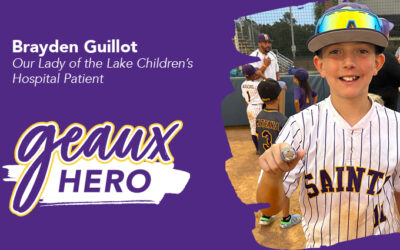When the school year approaches, some parents feel the clock ticking — especially if their child isn’t yet potty trained.
But when it comes to potty training, health experts agree that readiness matters more than any deadline.
Look for Signs of Readiness
Most children show signs of readiness between 2 and 3 years old, though some may not be fully trained until after age 4, and that’s OK. Learning to use the potty depends on developmental milestones, including bladder and bowel control, motor skills, and communication.
Some common signs your child may be ready include:
- Staying dry for longer periods
- Expressing interest in using the toilet
- Hiding to poop or telling you when they’ve gone
- Showing independence in tasks like dressing
Occupational, physical and speech therapists at Our Lady of the Lake Children’s Health Pediatric Development and Therapy Center also encourage parents to notice subtle signs.
If your child is removing their clothes or diaper when soiled, fussing or seeming uncomfortable, or beginning to follow daily routines, these are all indications they may be developmentally ready to begin potty training.
A child needs to be able to walk, recognize the need to go, and control the muscles needed to go. If your child hasn’t checked all those boxes yet, it may be best to wait a little longer.
Encouragement Over Expectation
Create a positive, low-pressure environment around potty learning. Let your child explore the potty without pressure — sitting on it fully clothed, decorating it with stickers or reading potty-themed books together.
Use praise and encouragement freely — even for small wins like pulling down pants, sitting on the potty, or trying. Accidents are part of the process and should never be punished.
Be mindful of the language you use. Words like ‘dirty’ or ‘naughty’ can unintentionally create shame. A neutral and supportive tone helps children build confidence.
Understanding Sensory Processing Challenges
Sensory processing plays a significant role in potty training success — or struggles.
Toilets and bathroom vents are loud, and that can be overwhelming for children with auditory sensitivities. Some kids may also struggle with interoception — their ability to feel internal body cues — which affects whether they notice the urge to go. Tactile sensitivities, like being uncomfortable with the cold toilet seat or the feel of toilet paper, can also be barriers.
By recognizing these sensory factors, parents can adjust the potty environment to be more child-friendly and less intimidating.
What About School Deadlines?
It’s true that some preschool programs require children to be potty trained. But not every child is on the same timeline, and rushing the process can cause setbacks.
If you’re feeling pressure and your child isn’t ready, open a conversation with the school, the therapists say. Good communication, consistency between home and school, and realistic expectations are key.
For children with an Individualized Education Program (IEP), schools may offer flexibility.
Potty Training for Children with Special Needs
Children with special needs may benefit from a customized potty plan.
Patience and consistency are essential. Therapists use visual schedules, pay close attention to non-verbal cues like fussing or pulling at clothes, and consider environmental modifications — like ensuring feet are supported on a stable surface.
Collaboration with therapists can make a big difference. Consider consulting with occupational therapists, physical therapists, pelvic floor specialists and speech therapists who can recommend adaptive equipment, safe transfer techniques, communication supports and more.
The goal is to support the child’s developmental timeline, not force a typical one-size-fits-all approach.
Tools and Tips for Positive Reinforcement
The therapists recommends incorporating playful, positive strategies to help children feel comfortable:
- Relaxation techniques like blowing bubbles or using a pinwheel while on the potty
- Reading social stories about potty training
- Ensuring feet are supported with a stool or child-sized seat
- Using whatever motivates your child — stickers, small toys, screen time — as a reward
- Praising every small success, from walking into the bathroom to wiping
The most important thing is creating a positive association with toileting. It’s not just about the end result but also celebrating every little step along the way.
Be Patient with the Process
Teaching a toddler to use the potty isn’t an overnight task. Most kids take between three and six months to potty train, but it can take more or less time depending on the child — especially if you start before they’re ready.
And nighttime dryness can take months or even years to fully master. That’s normal.
This is a common struggle! It feels hard because it is hard. Be ready with extra clothes, shoes, socks, wipes, and plastic bags — and know that you’re not alone.
If you’re wondering whether your child is on track, check in with your pediatrician for personalized support. Don’t let external pressure override your child’s needs. Trust your instincts, talk to your care team and remember: the goal isn’t just dry pants — it’s independence, confidence and comfort.




